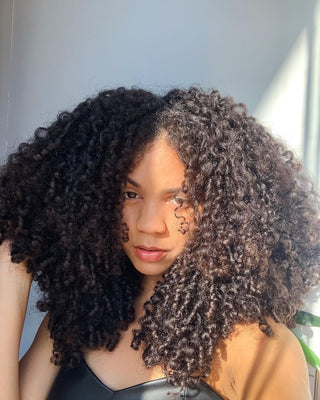Whether your hair is straight, wavy, curly, or coily, understanding its porosity can make a huge difference in treating those precious curls. It's all about how you style it, cut it, and even what products you grab on wash day. Now, let's be real, we all mess up sometimes when it comes to caring for our curly or coily hair. But don't worry, we’ve got your back! Here are seven things you gotta avoid like the plague if you're rollin' with high-porosity natural hair.
What is High-Porosity Hair, And What Are Its Characteristics?
Porosity is a way to determine your hair's ability to hold and absorb water. This measure then indicates how easily moisture can penetrate the hair. The cuticle, the top layer of your curly or coily hair, often controls how much moisture gets in and out of the hair, which can tell you how porous your hair is. Using heat, dye, or chemicals on your hair can change its porosity as it alters how your curls or coils absorb and hold onto moisture.
High porosity hair comes with a bunch of characteristics. Let's get into it:
Rapid Moisture Loss
When your hair slurps up all the product you put in but can't hold onto it for long, that's a telltale sign of high porosity hair. The lifted cuticles just can't retain the moisture, so you're constantly adding more.
Frizz
Ever run your finger down a strand of your hair and feel those little bumps? Those are the lifted cuticles that come with high porosity. And yep, you guessed it, they also contribute to frizzy hair.
Dry
If you're finding yourself reaching for water and sealants like a gel, cream, or mousse multiple times a day because your hair feels like a desert, chances are you're dealing with high porosity hair. It's like your hair has difficulty retaining moisture and dries up quickly.
Becomes Tangled Easily
Tangles are a pain for everyone, but they're even more common if you've got high porosity hair. The lifted cuticles make it easy for your hair strands to get all tangled up, forming knots and general hair chaos.
Dull
Dryness often leads to dullness, and high porosity hair is no exception. Since your hair can't retain moisture, it looks and feels dry. That's why folks with high porosity hair often slather on creams and oils to regain shine and moisture.
Breakage Prone
When your hair lacks proper moisture, it becomes brittle and prone to breakage. Dry hair lacks elasticity, so even a little strain can cause it to snap. High porosity hair could be the culprit if you're experiencing more breakage.
So, if you've noticed any of these signs, it's a good bet you're rockin' some high porosity hair. You can actually figure out your porosity pretty easily while washing your hair. If your hair takes forever to get fully wet, you have low porosity hair. On the other hand, if your hair soaks up water like a sponge and dries up real fast, you're dealing with high porosity.

What To Avoid When Caring For High-Porosity Hair
1. Limiting The Number Of Trims
Regular trims benefit high porosity hair because your curls or coils tend to be more prone to split ends due to their weakened structure. Trimming off the damaged ends helps remove weak and fragile hair, reducing the chances of breakage and promoting healthier hair growth.
Next, cutting your hair regularly can help eliminate excessively damaged areas with lifted cuticles, which are prone to moisture loss. Removing these damaged sections creates a smoother hair surface, allowing for better moisture retention within the hair shaft.
Although trimming doesn't directly make your hair grow faster, it does support healthier hair growth. By maintaining the overall health of your hair through regular trims, you create an optimal environment for your hair to grow and thrive. So, a half-inch cut of your curls should be done every four to six weeks.
2. Using Protein Treatments Too OftenAdding protein treatments to your routine is also important when you have high-porosity hair. Since high-porosity hair is weak and can experience breakage easily, adding protein will help to strengthen it. But, while protein can make your hair stronger, it can also make it dry if used too often. You only need a protein treatment once a month to treat your hair and keep it from breaking.
As high-porosity hair needs products that restore moisture, reduce frizz, seal in moisture, and protect the hair from heat, you should aim for the right mix of protein and moisture. To keep this balance, use a deep conditioner that adds moisture one week and one that adds protein the following week. Generally, you can make it easier by using a moisturising conditioner when your hair feels dry and a protein conditioner when it feels weak.

3. Forgetting To Pre-Poo and Detangle Before Shampooing
Those with high-porosity hair must not avoid pre-pooing and detangling before applying shampoo. This is because high-porosity hair can experience breakage and tangle easily. This is why you must ensure you detangle your natural hair using a mixture or one of your favourite oils as a pre-poo treatment before you step into the shower. This way, your hair doesn't get tangled and experience breakage when shampooing. Remember to detangle from the ends up to your roots. This will help ease stress and make it easier to get the knots out.
4. Not Educating Yourself On The Right Products To Use
As high porosity hair already has lifted cuticles, it is more susceptible to damage and moisture loss. So, chemical-based products containing harsh ingredients like mineral oil and synthetic fragrances can further strip away moisture and weaken the hair strands, leading to increased breakage and dullness.
So, if you're dealing with high porosity hair, it's best to go for those natural and gentle products for dry, damaged hair. You want stuff that doesn't have all those harsh chemicals, sulfates, or drying agents. Look for products packed with nourishing ingredients that'll give your hair the hydration it craves while also making it stronger and healthier. The goal is to avoid more damage or moisture loss, so stick to those gentle goodies for your high porosity hair. For instance, Sofnfree’s water-based cleansing shampoo is very moisturising due to its natural ingredients and doesn't contain sulphates that can strip the natural moisture from the hair.
Our shampoo is the perfect companion to our Moisture-Rich Conditioner, which moisturises and conditions your curls as it has a natural mix of manuka honey and avocado. Then to seal the moisture from this wash day, use a gel, cream, or mousse to lock the moisture in your curls for longer.

5. Not Taking Care When Drying High Porosity Hair
Instead of vigorously rubbing your hair with a towel, gently pat and squeeze the excess water. High-porosity hair is more prone to breakage, so a gentle touch prevents unnecessary damage. Then, Opt for a soft microfiber towel or an old cotton t-shirt to blot and absorb water from your hair. These materials are gentler and help minimize frizz. If possible, let your high-porosity hair air dry naturally. This allows the hair to retain more moisture.
6. Ignoring The Benefits Of Silk Or Satin When Sleeping
Because it is so fragile, high-porosity hair must be handled carefully. Make time to detangle your hair before sleeping using a wide-toothed comb, starting from the ends of your hair and then working your way up. Using scarves and pillowcases made of silk or satin helps the hair retain moisture, unlike cotton, which can strip its natural hydration. In addition to putting your hair in a silk or satin scarf at night, you can twist, wrap, or adopt a pineapple updo to seal the moisture in your hair.

7. Applying Heat To Your Hair Too Often
If you have high-porosity hair, heat damage is more of a reality, as this type of hair is already more prone to breakage. So, if you have to use a heat styling tool, blow-dry it on low heat so that the heat doesn't damage your hair. When you use heat to style your hair, you should always use a heat protectant. You can also improve the health of your natural hair by styling your hair without heat.
Once you know that being gentle is the key to a good routine for high-porosity hair, it's not hard to take care of it. If you're rocking those gorgeous curls or coils, there are a few important do's and don'ts. First off, when it comes to brushing, take it easy. Don't go yanking and tearing through those precious curls like a maniac. Next up, watch your hair-washing routine. Too much shampoo can strip away your hair's natural oils and leave it parched. Finally, be cautious with the heat styling. Your curls can't handle too much sizzle, or they'll end up thirsty, weak, and prone to breakage.

